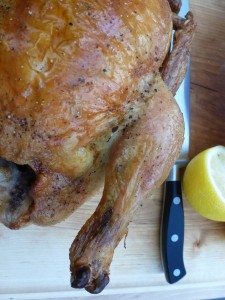 Crisp, delicate, golden skin. Moist, tender, well-seasoned flesh. A whole bird, brought to the table and broken into pieces, distributed amongst the diners according to their personal preferences. This is the beauty and simplicity of the ideal roast chicken dinner.
Crisp, delicate, golden skin. Moist, tender, well-seasoned flesh. A whole bird, brought to the table and broken into pieces, distributed amongst the diners according to their personal preferences. This is the beauty and simplicity of the ideal roast chicken dinner.
You can go to ridiculous lengths to roast the perfect chicken – (see the In Search of Perfection episode on roast chicken, which involves brining, soaking in water, scalding three times, cooking in the oven for five hours, then searing on the stove top…) – but with a fraction of the effort you can have mostly the same results as the most complicated procedures.
The following process results in by far the highest ratio of eating quality to effort. All it takes is some planning.
Truly crisp skin is something of a rarity in chicken; the meat cooks so quickly that the skin usually doesn’t get exposure to enough intense heat. To crisp properly, the skin has to be absolutely dry before the bird goes in the oven. To achieve this, thoroughly pat the bird with paper towels, then leave it on a wire rack in the fridge, uncovered, for 24 to 48 hours. This is the part that requires planning ahead, but it makes a huge difference.
This day-or-two drying also gives us the opportunity to season the meat, as well as increase its tenderness and moisture-holding capacity. Season the bird judiciously with salt before putting it in the fridge to dry. Get salt in every cavity and crevice. The salt will penetrate the meat, almost as if the chicken were in a brine.
Usually at this point a chef would truss the chicken, tie it with twine to keep the legs and wings close to the body so that the bird cooks evenly. While I do tuck the wings underneath the body of the chicken, I leave the legs in their vulnerable, splayed position. The reason is this: The light meat of the chicken breast is best cooked to 155°F, while the dark meat of the legs is done at 165°F. Trussing ensures that the breast meat will overcook before the legs are done. Again, you can go through all kinds of trouble to try and correct this (applying ice packs to the raw breasts so they start at a lower temperature than the legs, cutting up the bird before roasting so that the breasts and legs can be removed at different times, and so on…) but leaving the legs to fall away from the body exposes them to more heat, so they reach their finishing temperature at more or less the same time as the breasts.
Since chickens are so small and cook so quickly, the oven has to be blisteringly hot for the skin is crisp before the meat is overcooked. After lightly oiling the bird, I roast at 450°F. Even at this temperature it takes maybe 30-45 minutes for the meat to cook through.
So simple. So good.
By the way I stole most of this info from On Food and Cooking and The Zuni Cafe Cookbook.
